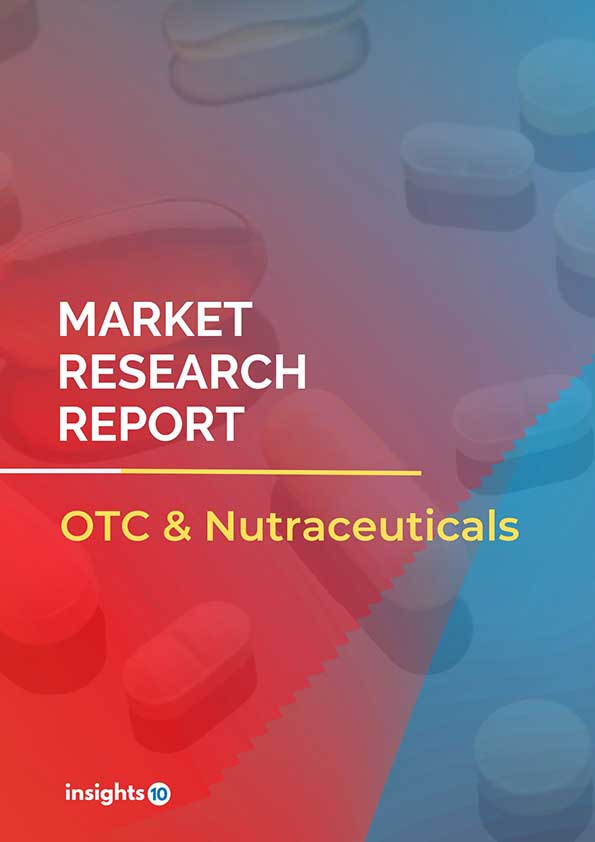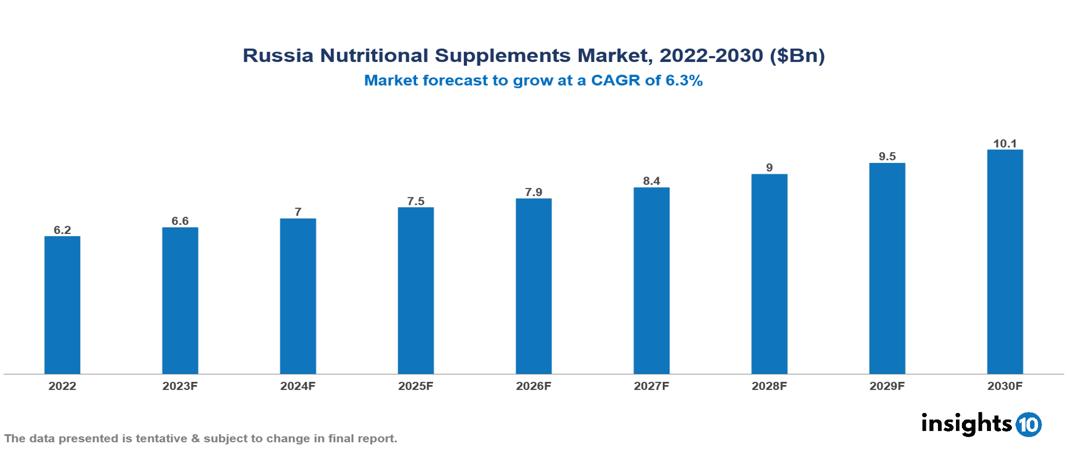Russia Nutritional Supplements Market Analysis
By 2030, it is anticipated that the Russia Nutrition and Supplements market will reach a value of $10.1 Bn from $6.2 Bn in 2022, growing at a CAGR of 6.3% during 2022-30. The market is primarily dominated by local players such as DHA Group, Vina Pharma, and Greenlife Nutrition. The market for nutrition and supplements in Russia is primarily driven by an inclination towards offline purchases, government regulations, and increasing consumer awareness of health and lifestyle. The Russian nutrition and supplements market in Russia is segmented by Type, Product, application, and Distribution Channel.
Buy Now

Russia Nutrition and Supplements Market Analysis Summary
By 2030, it is anticipated that the Russia Nutrition and Supplements market will reach a value of $10.1 Bn from $6.2 Bn in 2022, growing at a CAGR of 6.3% during 2022-30.
Early in the 1990s, foreign manufacturers dominated the market for nutrition and supplements; however, at present, Russian businesses now account for 70% of the market. According to the current trend, 50% of people who buy supplements and nutrition products are between the ages of 20 and 44, while 50% of people who buy drugs are between the ages of 45 and 65.
In 2019, Russia's annual GDP for healthcare was 5.65%. A growing number of people are interested in the nutrition supplement industry. Prior to now, the Russian market primarily sold imported nutritional supplements, but local businesses are quickly filling this gap. When many foreign manufacturers left the Russian market, this process picked up speed. The Siberian Federal District of Russia had the highest per capita consumption of nutrition and supplement products, with 3.3 packages consumed on average during the first nine months of 2021. In Russia, 341 Mn bottles of nutrition supplements were bought and sold in total during that period.
Market Dynamics
Market Growth Drivers
Although websites had a sizable market share in Russia, most manufacturers now prefer to sell through pharmacies because customers trust them more than other channels of distribution. The market is expected to grow in two directions: regional sales will account for a larger portion of sales, and social and new-age consumer groups will become more involved. These factors can drive the market in a positive direction for new players.
Market Restraints
Strict rules must be followed, which may deter new competitors from entering the Russian market for nutrition supplements. For instance, pre-market approval is necessary before putting certain vitamins, mineral supplements, and herbal ingredients into products. The authorities keep a list of prohibited plants that cannot be used as food supplements, herbal ingredients, or supplements, and the herbal ingredients can also be categorized as supplements.
Competitive Landscape
Key Players
- Evalar (RUS)
- Ria-Panda (RUS)
- Pharmstandard (RUS)
- Biotics Research Corporation (RUS)
- Natur Produkt (RUS)
- Holford (RUS)
- Nutrilite (RUS)
- GNC
- GlaxoSmithKline
- Nestlé
Healthcare Policies and Reimbursement Scenarios
In Russia, the Federal Service for Surveillance in Healthcare (Roszdravnadzor) is in charge of regulating nutrition supplements. This organization is in charge of guaranteeing the effectiveness, safety, and quality of medical products, including nutrition supplements. A manufacturer must confirm that the product can be registered as a nutrition supplement, create and submit a registration dossier, examine the sample, arrange for the import of the product into Russia (if necessary), and communicate with Rospotrebnadzor and accredited expert laboratories in order to successfully launch a nutrition supplement on the Russian market.
A variety of medical services, including inpatient and outpatient care, prescription medications, and some preventive services, are covered by Russia's national healthcare system. Supplemental nutrition is not typically covered by national health insurance or reimbursement programs. Customers typically have to pay for these items out of pocket.
1. Executive Summary
1.1 Product Overview
1.2 Global Scenario
1.3 Country Overview
1.4 Healthcare Scenario in Country
1.5 Government Regulation in Country
1.6 Recent Developments in the Country
2. Market Size and Forecasting
2.1 Epidemiology of Disease
2.2 Market Size (With Excel and Methodology)
2.3 Market Segmentation (Check all Segments in Segmentation Section)
3. Market Dynamics
3.1 Market Drivers
3.2 Market Restraints
4. Competitive Landscape
4.1 Major Market Share
4.2 Key Company Profile (Check all Companies in the Summary Section)
4.2.1 Company
4.2.1.1 Overview
4.2.1.2 Product Applications and Services
4.2.1.3 Recent Developments
4.2.1.4 Partnerships Ecosystem
4.2.1.5 Financials (Based on Availability)
5. Reimbursement Scenario
5.1 Reimbursement Regulation
6. Methodology and Scope
Russia Nutritional Supplements Market Segmentation
The Nutritional Supplements Market is segmented as mentioned below:
By Product (Revenue, USD Billion):
- Sports Nutrition
- Sports Food
- Sports Drinks
- Sports Supplements
- Fat Burners
- Green Tea
- Fiber
- Protein
- Green Coffee
- Others (Turmeric, Ginseng, Cranberry, Garcinia Cambogia)?
- Dietary Supplements
- Vitamins
- Minerals
- Enzymes
- Amino Acids
- Conjugated Linoleic Acids
- Functional Foods
- Probiotics
- Omega-3
- Others
By Consumer Group (Revenue, USD Billion):
- Infant
- Children
- Adults
- Pregnant
- Geriatric
By Formulation (Revenue, USD Billion):
- Tablets
- Capsules
- Powder
- Softgels
- Liquid
- Others
By Delivery Channel (Revenue, USD Billion):
- Chemists/Pharmacists
- Direct-to-Consumer Sales
- E-commerce
Methodology for Database Creation
Our database offers a comprehensive list of healthcare centers, meticulously curated to provide detailed information on a wide range of specialties and services. It includes top-tier hospitals, clinics, and diagnostic facilities across 30 countries and 24 specialties, ensuring users can find the healthcare services they need.
Additionally, we provide a comprehensive list of Key Opinion Leaders (KOLs) based on your requirements. Our curated list captures various crucial aspects of the KOLs, offering more than just general information. Whether you're looking to boost brand awareness, drive engagement, or launch a new product, our extensive list of KOLs ensures you have the right experts by your side. Covering 30 countries and 36 specialties, our database guarantees access to the best KOLs in the healthcare industry, supporting strategic decisions and enhancing your initiatives.
How Do We Get It?
Our database is created and maintained through a combination of secondary and primary research methodologies.
1. Secondary Research
With many years of experience in the healthcare field, we have our own rich proprietary data from various past projects. This historical data serves as the foundation for our database. Our continuous process of gathering data involves:
- Analyzing historical proprietary data collected from multiple projects.
- Regularly updating our existing data sets with new findings and trends.
- Ensuring data consistency and accuracy through rigorous validation processes.
With extensive experience in the field, we have developed a proprietary GenAI-based technology that is uniquely tailored to our organization. This advanced technology enables us to scan a wide array of relevant information sources across the internet. Our data-gathering process includes:
- Searching through academic conferences, published research, citations, and social media platforms
- Collecting and compiling diverse data to build a comprehensive and detailed database
- Continuously updating our database with new information to ensure its relevance and accuracy
2. Primary Research
To complement and validate our secondary data, we engage in primary research through local tie-ups and partnerships. This process involves:
- Collaborating with local healthcare providers, hospitals, and clinics to gather real-time data.
- Conducting surveys, interviews, and field studies to collect fresh data directly from the source.
- Continuously refreshing our database to ensure that the information remains current and reliable.
- Validating secondary data through cross-referencing with primary data to ensure accuracy and relevance.
Combining Secondary and Primary Research
By integrating both secondary and primary research methodologies, we ensure that our database is comprehensive, accurate, and up-to-date. The combined process involves:
- Merging historical data from secondary research with real-time data from primary research.
- Conducting thorough data validation and cleansing to remove inconsistencies and errors.
- Organizing data into a structured format that is easily accessible and usable for various applications.
- Continuously monitoring and updating the database to reflect the latest developments and trends in the healthcare field.
Through this meticulous process, we create a final database tailored to each region and domain within the healthcare industry. This approach ensures that our clients receive reliable and relevant data, empowering them to make informed decisions and drive innovation in their respective fields.
To request a free sample copy of this report, please complete the form below.
We value your inquiry and offer free customization with every report to fulfil your exact research needs.










































